Masterclass: lobster tartare by Guy Owen
Guy Owen at the Idle Rocks in St Mawes, Cornwall, is taking a leap of faith with his lobster tartare, trusting the quality of the local produce and relying on his own skill in a simple, effective dish where there’s nowhere to hide. Michael Raffael finds out more.
According to the government’s latest UK Sea Fisheries Report, fishermen landed 80,900 tonnes of mackerel and 3,000 tonnes of lobster in 2018. More significant are their respective values: lobster was worth £44.1m and mackerel £84.7m, making the mackerel catch that’s nearly 30 times larger worth less than twice as much as the lobster.
Chefs will be aware that the fish yields about half its weight in meat, and that the crustacean, when it’s in good nick and well-handled, gives about 20%. Anyone brave enough to put lobster (British, as opposed to North American imported) on their menu faces two main challenges.
They commit to serving a luxury product, so there’s no margin for error, but more tricky is solving the problem of how to present it: play safe or be original.
At Idle Rocks in St Mawes, Cornwall, head chef Guy Owen has the ideal seafront setting to showcase Cornish lobster. By serving it as a tartare, he’s taking a leap of faith in his own skill and palate. At the same time, he is trusting that customers who have tasted it grilled, sauced or in a salad will like it just as much raw.
###Planning
- Make the apple and cucumber balls
- Make the apple purée
- Make the lemon purée
- Make the dill oil
- Shell the lobster
- Cure the lobster
- Make the dressing to bind the lobster
- Make the apple dressing.
###Cost
Idle Rocks has a £60, three-course à la carte menu and an £80 tasting menu. The kitchen aims for 70% gross profit. Wholesale lobster cost is £15-£16 per kilo. “Cripples” – lobsters missing a claw – are cheaper and suitable here.
###Ordering lobster
It isn’t enough to order ‘live’ lobster – they also have to be lively. Those held in vivariums lose condition and can lose weight. For this dish, Guy Owen won’t buy female lobsters with eggs, partly to preserve native stocks and partly because it reduces the yield in a recipe where the tail meat is important.
Shelled, the tail and claw meat will be about 20% of the total weight. For this recipe, buying the standard 600g lobster isn’t essential.
Taken fresh out of the sea, healthy lobsters flap their tails. Many chefs put them in the freezer for 30 minutes or so before cooking to make them sluggish and easier to handle.
Animal welfare bodies encourage chefs to kill lobsters before dropping them in boiling water. This has a practical benefit too, as the tail stays relatively straight and is easier to handle.
###Cured lobster tail
Serves 2
Note: the quantity of salt cure can be scaled up as necessary. (For the photo – two portions – only a quarter was used)
- 120g approx dill with stalks
- 250g sea salt
- 250g caster sugar
- Grated zest 1 lime
- Grated zest 1 lemon
- 1 medium 700g lobster
Finely chop the dill stalks to obtain four tablespoons of diced herbs. Combine with the salt, sugar and lime and lemon zest.
Bring a large pan of water to a rolling boil. To kill the lobster, insert a knife point into the cross in the middle of the carapace and split it between the eyes.
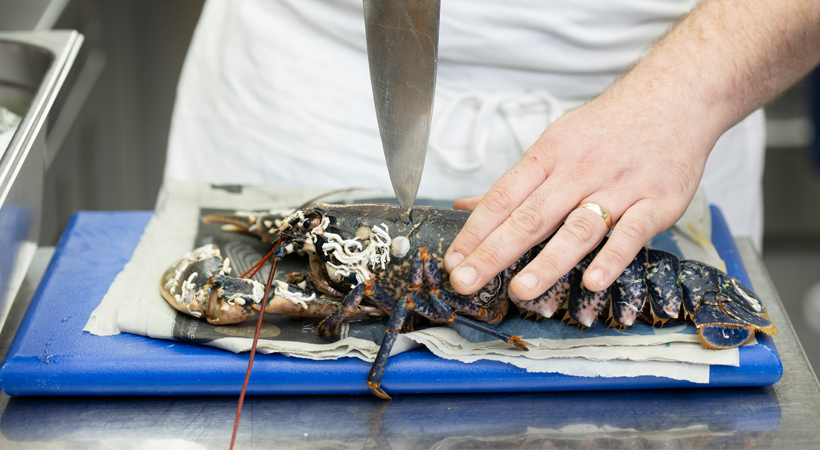
Drop it head-first in boiling water for only 40 seconds. It won’t cook, but the pigmentation of the shell and flesh will start to change colour.
Remove the lobster from the pan. Twist off the claws and the tail. Reserve the carapace, the claws (they’ll need extra cooking) and the black, uncooked roe for stocks, sauces or amuse-bouche.
Press the tail down with the flat of the hand to break the shell while it’s still warm. Pull the shell off the tail meat. Lay the tail flat on the work surface, rounded side uppermost. Make a slit through the middle of the tail along its length to expose the natural seam through the middle. Remove any trail of intestines and split the tail into two.
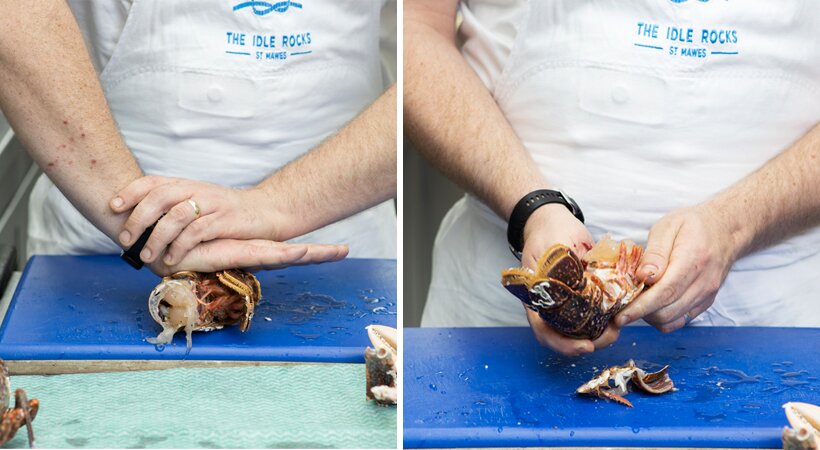
Sprinkle some of the cure on a small tray. Lay the lobster on top. Cover completely with more cure and leave for about 30 minutes.
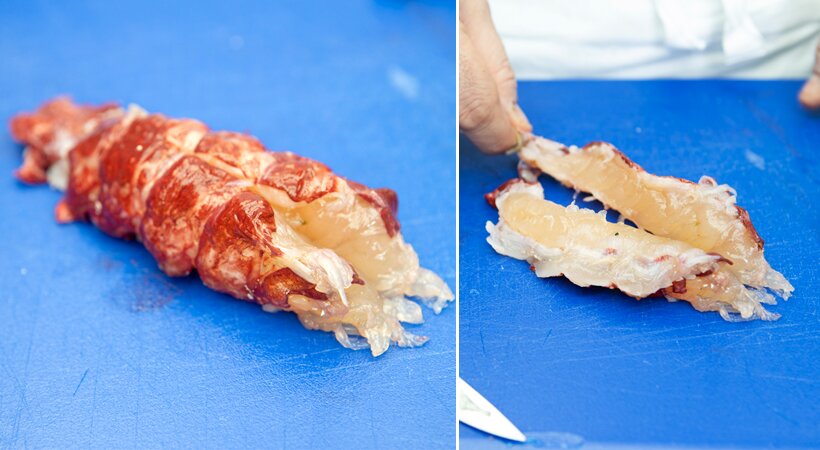
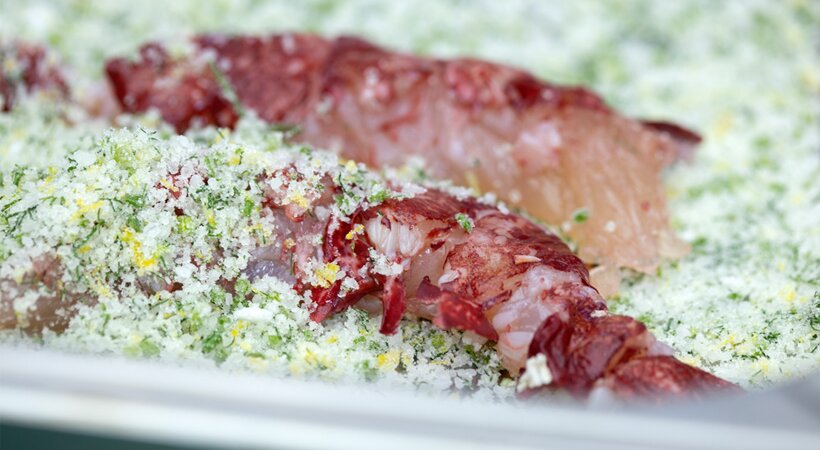
Remove the lobster from the cure and rinse off the salt under running water. Cut each half of the tail into small nuggets, each smaller than a little fingernail. Allow about 60g per portion.
Apple and cucumber balls
Prepare two containers. Pour about 450ml of cold water into each one. Mix a scant teaspoon of ascorbic acid with each container of water.
Take a parisienne cutter (12mm) and scoop out balls of cucumber and eating apple. Leave the skins on both. How many you make depends on the batch size, but allow six of each per portion.
Apple purée
Makes about 450g
- 6 Cox’s apples
- 1 heaped tsp ascorbic acid
- About 2tbs Ultratex
Quarter the apples and core them. Leave on the skin. Put them in the Vitamix with the ascorbic acid and blend thoroughly. Pass through a chinois lined with cheesecloth and leave to drip for an hour. Discard the pulp and transfer half the liquor to a bowl. Beat in the Ultratex.
Reserve the rest of he liquid – this is the apple consommé used when dressing the dish.
Bergamot lemon purée
Makes about 300g
- 12 Moroccan Beldi (bergamot) preserved lemons
- 200ml stock syrup
Blend the whole lemons in a Vitamix and add the stock syrup, a little at a time, until the mixture is smooth and there’s a balance of sweetness and acidity.
Chef’s tip: Empty both the apple and lemon purées into steep-sided containers. Put them into a vacuum machine and switch on to extract the air. This gives them extra gloss and a silky texture. The mixes froth up, so be careful not to overfill the containers.
###Cornish lobster tartare, apple, cucumber, lemon, crème fraîche
Serves 1
- 6 cucumber balls
- 6 apple balls
- 5 dots of lemon purée
- 5 dots apple purée
- Dill and purple amaranth sprigs
- 60g cured, chopped lobster (mixed with a little rapeseed oil, lemon juice and salt to bind)
- 1 heaped tsp Lancashire crème fraîche
- Drops of dill oil
- 1tbs apple consommé, split with dill oil
- 1 shredded oyster leaf
Put a 10cm cutter or hoop in the centre of the plate. Alternate cucumber and apple balls around it.
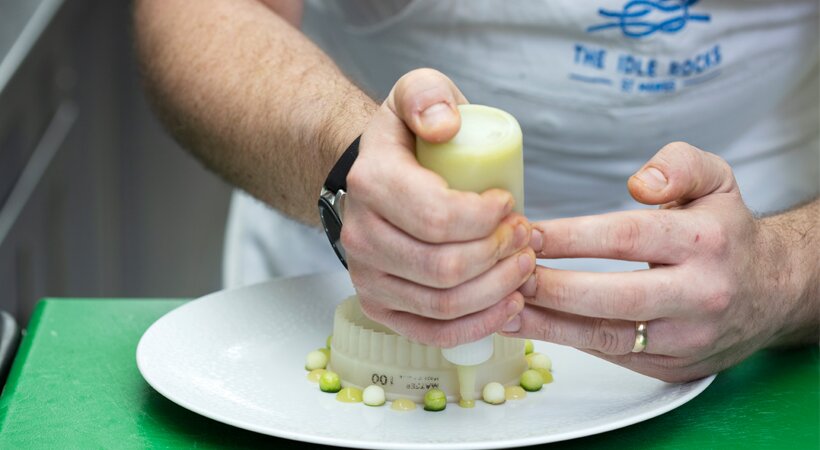
Dab matching blobs of lemon and apple purée into the gaps between them. Decorate each ball with amaranth and dill. Use two large spoons to form a chopped lobster quenelle. Put it inside the hoop but to one side. Remove the hoop and spoon crème fraîche next to the lobster. Make a dent in it and fill with dill oil. Pour a little apple consommé next to the lobster quenelle and finish with shredded oyster leaf.
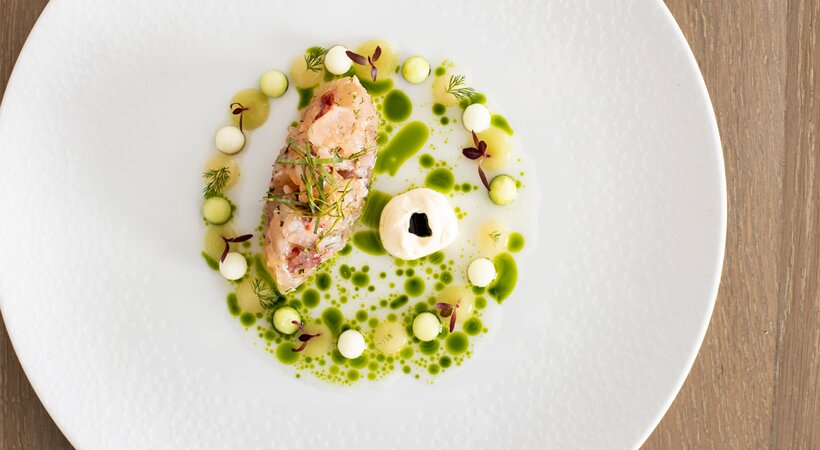
Dill oil
Makes about 350ml
Cook 350g baby spinach leaves in boiling water until they have softened but not changed colour. Drain and squeeze out any extra moisture. Heat 350ml oil to 60°C. Blend the spinach and 200g dill in a Vitamix. Strain through muslin or cheesecloth into a bowl and leave for about 30 minutes. Reserve in a squeezy bottle.



















